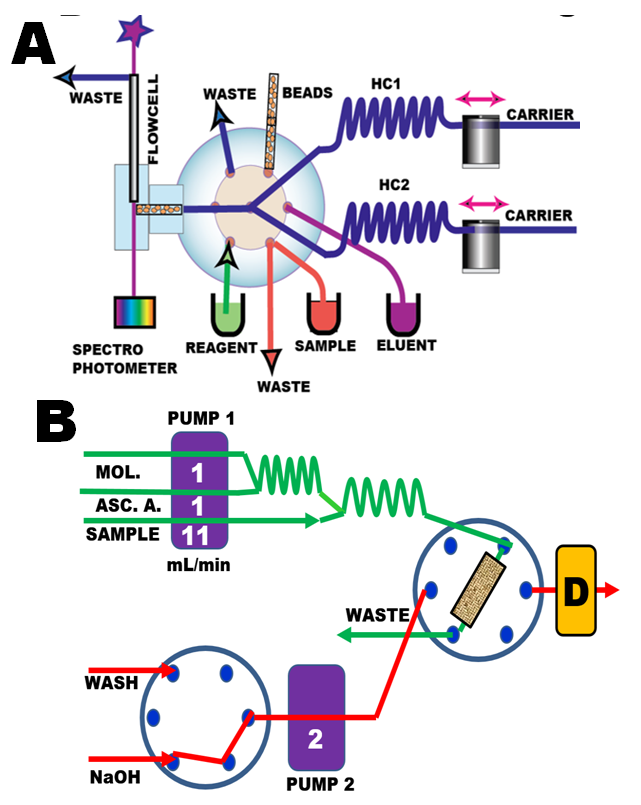Comparison of Phosphate Assays Performed in cFI and pFI Format
3.2.7.
While the pFI-SE method (A) presented here for the first time, is novel, the obvious question is, if it is any better the conventional (cFI-SE) methodology, based on nesting column within two position valve (B). The answer is in comparison of results and performance of the same SE based assay automated by these two different techniques.
The SE based determination of phosphate designed by Heckermann (2000), was automated by cFI-SE and used for analysis of sea water (Ma 2008, 2017). A cartridge of HLB polymeric sorbent was nested within a valve (B). Sample (volume 50mL) was loaded at a flow rate of 11mL/min followed by 40 second wash time, thus yielding frequency of 12s/hr, LOD 1nM P/L with a slope of calibration line 0.09 AU/ppB P or 2.8 AU/mM P (Ma 2017 section 2.4.)
It turns out that the analytical performance of cFI-SE and pFI-SE methods is identical, although cFI-SE technique uses 4.5x2=9mL of reagents and 50 mL of sample per assay, while pFI-SE uses only 1.6mL of sample and 0.6mL of reagents, to perform a double loading cycle (sensitivity of 0.09 AU/ppB P or 2.8 AU/mM P at a rate of 12s/hr.). The cartridge used in cFI-SE method contains 3000 microliters of sorbent, while renewable microcolumn is fully packed with 20 microliters of sorbent.
This comparison should not be viewed as a critique of the pioneering works of Ma and coworkers, who tested the cFI-SE method on board performing sea water assays, while pFI-SE , presented here, is at its early stage of development. However, this comparison provides compelling input for further development of pFi-SE also, because the instrument used for pFI is more advanced, more robust and more reliable than cFI instruments, which have large internal volumes and are burdened by performance and running cost of peristaltic pumping. Furthermore, the pFI-LOV instrument can also be used to automate other nutrient assays (1.2.32.). (Ruzicka 2018, Hatta 2018)
As to the choice of methodology for determination of traces of nutrients in sea water, sorbent extraction is the method of choice, compared to long light path (LWG) flow cell or MAGIC method based on coprecipitation (Ma 2017 section 1)
Heckemann, H.J., “Highly sensitive flow analysis determination of orthophosphate using solid phase enrichment of phosphomolybdenum blue without need for organic solvents in elution”. Anal. Chim. Acta410, (2000.) 177–184.
J.Ma, D.Yuan,Y.Liang. “Sequential injection analysis of nanomolar soluble reactive phosphorus in seawater with HLB solid phase extraction.. Marine Chemistry 111, (2008) 151.
J. Ma, Y.Yuan, D. Yuan, Y. “Underway analysis of nanomolar dissolved reactive phosphorus in oligotrophic seawater with automated on line solid phase extraction and spectrophotometric system:. Anal.Chim.Acta 950 (2017) 80.
J. Ruzicka, “Redesigning flow injection after 40 years of development. Flow programming” Talanta 176 (2018) 437.
M. Hatta, Ch.I.Measures, J.Ruzicka “ Programmable flow injection. Principle, methodology and application for trace analysis of iron in sea water matrix” Talanta 178, (2018) 698.
M. Hatta, Ch.I. Measures, J. Ruzicka “Determination of traces of phosphate in sea water is automated by programmable flow injection, and optimized by means of novel information on kinetics of formation and spectra of phosphomolybdenum blue” Talanta 2018 submitted..










